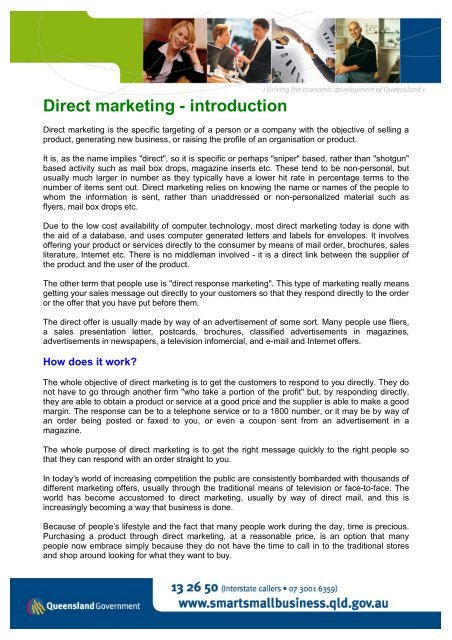Direct Marketing - Introduction.pdf - AJML Group
Direct Marketing - Introduction.pdf - AJML Group
Direct Marketing - Introduction.pdf - AJML Group
You also want an ePaper? Increase the reach of your titles
YUMPU automatically turns print PDFs into web optimized ePapers that Google loves.
<strong>Direct</strong> marketing - introduction<strong>Direct</strong> marketing is the specific targeting of a person or a company with the objective of selling aproduct, generating new business, or raising the profile of an organisation or product.It is, as the name implies "direct", so it is specific or perhaps "sniper" based, rather than "shotgun"based activity such as mail box drops, magazine inserts etc. These tend to be non-personal, butusually much larger in number as they typically have a lower hit rate in percentage terms to thenumber of items sent out. <strong>Direct</strong> marketing relies on knowing the name or names of the people towhom the information is sent, rather than unaddressed or non-personalized material such asflyers, mail box drops etc.Due to the low cost availability of computer technology, most direct marketing today is done withthe aid of a database, and uses computer generated letters and labels for envelopes. It involvesoffering your product or services directly to the consumer by means of mail order, brochures, salesliterature, Internet etc. There is no middleman involved - it is a direct link between the supplier ofthe product and the user of the product.The other term that people use is "direct response marketing". This type of marketing really meansgetting your sales message out directly to your customers so that they respond directly to the orderor the offer that you have put before them.The direct offer is usually made by way of an advertisement of some sort. Many people use fliers,a sales presentation letter, postcards, brochures, classified advertisements in magazines,advertisements in newspapers, a television infomercial, and e-mail and Internet offers.How does it work?The whole objective of direct marketing is to get the customers to respond to you directly. They donot have to go through another firm "who take a portion of the profit" but, by responding directly,they are able to obtain a product or service at a good price and the supplier is able to make a goodmargin. The response can be to a telephone service or to a 1800 number, or it may be by way ofan order being posted or faxed to you, or even a coupon sent from an advertisement in amagazine.The whole purpose of direct marketing is to get the right message quickly to the right people sothat they can respond with an order straight to you.In today’s world of increasing competition the public are consistently bombarded with thousands ofdifferent marketing offers, usually through the traditional means of television or face-to-face. Theworld has become accustomed to direct marketing, usually by way of direct mail, and this isincreasingly becoming a way that business is done.Because of people’s lifestyle and the fact that many people work during the day, time is precious.Purchasing a product through direct marketing, at a reasonable price, is an option that manypeople now embrace simply because they do not have the time to call in to the traditional storesand shop around looking for what they want to buy.
Why do it?<strong>Direct</strong> marketing usually has the following main aims:• To acquire new customers.• To capture the attention of busy people - usually with an item attached/enclosed.• To promote a new product.• To invite customers to renew a subscription/service.• To invite the recipient to a seminar/conference.In any of the above, the objective is to use the mail piece as a catalyst - that is something thatcauses a reaction. In this case to make the phone ring, people to order a sample of the newproduct, renew a subscription etc. The offer is usually very specific - it generally revolves aroundone product or service, rather than sending a catalogue with which a reader may get swamped.What advantages does it have over other activity?Unlike magazine ads, mailbox drops or the like, with the power of a database, one can easily testthe response to the letter/offer before going ahead with a full scale promotion and finding that thisdoes not work, or is attracting the wrong sort of response. This way, adjustments and fine-tuning tothe promotion can be achieved by measuring the results, unlike a scatter-gun approach, whichtends to be all or nothing - e.g. magazine advert etcProvided that the content is specific and easily readable, you can be assured that the recipient willreceive and read the material, because it is personally addressed. With the capabilities of today’sdirect marketing programs it is possible to personalise the letter in all manner of ways such as toinclude details of previous purchases or other information specific to the recipient of the letter.It is cost effective. If the right target is reached with the right offer, depending on the nature of theproduct/opportunity being presented one can often achieve the same or better results from a directmail campaign than a generalised advertisement. This comes back to defining the objectives of themarketing exercise in the first place.Unlike scatter-gun marketing activities, because the actual target is known, it is possible to followup the mail piece with a telephone call to reinforce the branding/sales/promotional exercise. It is awell-known fact that the more ways in which a product/service is promoted the better the uptake,for example, bill boards coinciding with TV and newspapers ads etc.In any direct marketing activity, the response from people receiving the material will be one ofthree types:• Receive the material and respond to same - typically a small number.• Receive the material and do nothing - the greater percentage.• The sit on the fence people - those who read the material but are too busy or need a littlenudge to act upon it.The advantages of direct marketing allow for people to be moved from one group to another by thepersuasive power of a follow up call.
The changes in societyIn the world we live in certain things have changed. Competition has increased tremendously sothe fight for customer loyalty is fierce. There are an increased number of products and servicesavailable on the market. There is a huge mountain of marketing messages being presented all thetime, which is causing confusion to the buying public. Today’s buyer is a lot more knowledgeableand will only buy that which is a better price or produces a better advantage.The traditional way of marketing, however, is still strong for many reasons. Many customers stillwant to be able to see to someone face to face and discuss a purchase before completing it. Manycustomers are loyal to their suppliers they have been dealing with for many years and do not feelcomfortable with buying from a faceless supplier through direct mail etc.Further informationThe following fact sheets provide further information on these issues:• <strong>Direct</strong> marketing – advanced• <strong>Direct</strong> marketing campaign• Email marketing and the Privacy Act 1998 (Cwlth)• <strong>Marketing</strong> plan








